Also, Dr. Syversen explains high doses of TNFi’s are used during induction and that these high doses may have hampered the effectiveness of therapeutic drug monitoring during the induction phase of therapy. She hypothesizes that therapeutic drug monitoring may be more effective during maintenance therapy and will explore that question in the NOR-DRUM B trial.
Of note, a subset of patients in the NOR-DRUM A study—those developing anti-drug antibodies—did benefit from therapeutic drug monitoring. The authors write that this subset (18% in the therapeutic drug monitoring group and 17% in the standard therapy group) may have been too small to influence the results on a group level, but the role of therapeutic drug monitoring for these patients should be evaluated more closely.
Additionally, 10% of patients in the therapeutic drug monitoring group and 15% of patients in the standard therapy group had anti-drug antibodies above the threshold for discontinuation defined in the treatment algorithm. Because infliximab is the most immunogenic TNFi, with the highest interindividual variation in serum concentrations, Dr. Syversen does not believe therapeutic drug monitoring would be more effective during the induction of other TNFi’s.
The researchers documented a significantly lower rate of infusion reactions in the therapeutic drug monitoring group than in the control group, suggesting a role of proactive therapeutic drug monitoring in preventing infusion reactions, and they intend to explore this in future studies.
Lara C. Pullen, PhD, is a medical writer based in the Chicago area.
Reference
- Syversen SW, Goll GL, Jorgensen KK, et al. Effect of therapeutic drug monitoring vs standard therapy during infliximab induction on disease remission in patients with chronic immune-mediated inflammatory diseases. JAMA. 2021. 325(17):1744–1754.


